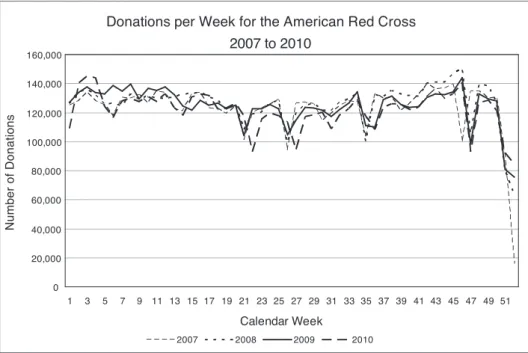229
Scientiic Comments
Rev Bras Hematol Hemoter. 2013;35(4):225-41
Comment on: “Temporal distribution of blood donations in three Brazilian blood centers
and its repercussion on the blood supply”
Roger Dodd Edward Notari
American Red Cross, Holland Laboratory, Rockville, MD, USA
Conlict-of-interest disclosure:
The authors declare no competing inancial
interest
Submitted: 5/6/2013 Accepted: 5/17/2013
Corresponding author: Roger Y Dodd
American Red Cross, Holland Laboratory
15601 Crabbs Branch Way Rockville MD 20855, USA
Roger.Dodd@redcross.org
www.rbhh.org or www.scielo.br/rbhh
DOI: 10.5581/1516-8484.20130067
As pointed out by Lorenzo Oliveira et al., the primary role of a blood center is the provision of a safe, economical and adequate blood supply(1). However, different factors govern the provision and the use of blood. An adequate supply of blood is based upon the availability of willing donors, while its usage depends upon medical need. It is clear that the concept of need only stimulates donors when dramatic circumstances such as natural disasters occur. It is frequently the case that modern disasters do not actually need a great deal of blood and indeed, the generosity of donors may be wasted. In view of this, a more effective system of communication and blood resource sharing in emergency situations has been developed in the United States.
However, it is well-recognized that seasonal variation in the supply of blood is a pervasive problem. In the USA, there are times of the year when local or national appeals for blood donors may well be anticipated – for example during the summer or the Christmas/New Year holiday season. Careful inspection of Figure 1 shows the general reduction in collections during the middle part of the year (summer in the Northern hemisphere). Less apparent is the fact that the demographic structure of the donor population changes seasonally, unexpectedly affecting (for example) the prevalence if infectious disease markers. We have noted more irst-time donors in the summer, and as might be expected, fewer donors in schools and colleges. This is, to a large extent, a consequence of the practice of collecting blood in locations away from the blood center itself, along with an increasing focus on younger blood donors.
Certainly in the USA, a great deal of effort is put into recruitment of donors and such efforts are managed in the context of awareness of the drivers of blood shortages. Consequently, analysis of the number of blood units collected does not tell us as much as we may anticipate, because the data are a result of more or less successful efforts to overcome predictable shortages. Nevertheless, prompted by the accompanying paper, we analyzed weekly blood collection data for the American Red Cross, which collects about 40% of the 14 million blood donations in the USA (Figure 1). Clearly evident are repeated decrements around Weeks 21-22 (end of May), 26-27 (early July), 34-36 (beginning of September) and 46-47 (mid-late November). Also, as might be expected, there is a decline in the irst and last weeks of the year, although it should be noted that the analysis is based upon each week starting on a
Figure 1 – Blood collections by week, American Red Cross. Week 1 starts on the irst Sunday in the calendar
230
Scientiic Comments
Rev Bras Hematol Hemoter. 2013;35(4):225-41
Sunday, so the steep decline for week 52 is, in part, an artefact due to the truncation of this ‘week’. The periods noted correspond to national holiday periods: Memorial Day, Independence Day, Labor Day, Thanksgiving and Christmas/New Year, respectively. Memorial and Labor days are held on a Monday, Independence Day is always July 4th (but observed on a weekday if falling on the weekend) and Thanksgiving is the fourth Thursday in November (many individuals are also on leave the following Friday). There are other holidays within the year, but they do not enjoy universal celebration, so do not clearly impact the collection data.
On the whole, it is evident that blood collection organizations can adjust to predictable reductions in collections, but some logistic dificulties will be apparent for platelets, with a 5-day shelf-life. However, modeling studies suggest that unexpected surges in
blood use, or shortages due to severe weather, an outbreak of inluenza, etc. may have severe impacts upon blood availability. Where feasible, such events may be ameliorated by carefully organized resource sharing – that is, blood components may be shopped from locations that are less affected. However, in the absence of such mechanisms, local plans for donor mobilization should be developed and in place as part of emergency planning.
References
1. Lorenzo Oliveira C, Almeida-Neto C, Jing Liu E, Sabino EC, Leão SC, Loureiro P. Temporal distribution of blood donations in three Brazilian blood centers and its repercussion on the blood supply. Rev Bras Hematol Hemoter. 2013;35(4):246-51.
